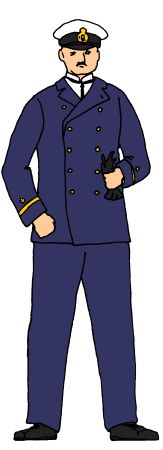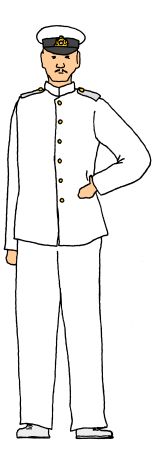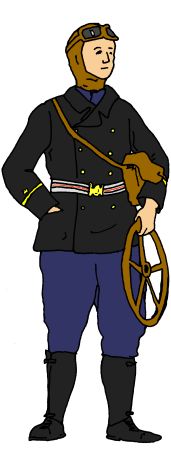|
Imperial German Navy
Officers Uniforms
|
 |
 |
 |
|
Figure 1
Naval Officer
Tsingtao Garrison
Japan 1916 |
Figure 2
Naval Officer
East Asian Fleet
Samoa c1910 |
Figure 3
Naval Pilot Officer
Tsingtao Garrison
Tsingtao 1914 |
Uniforms of the Officers of the Imperial German Navy
This page (and the page on
Other Ranks of the Imperial
German Navy) is only intended to give a brief introduction to
the topic of Imperial German Naval uniforms in general as worn in
home bases in Germany and China, and while at sea. For variations on Imperial German
Naval uniforms worn in other theatres see the pages on Naval
Landing Parties in the Tropics, the
Navy
in the Ottoman Empire and the
Navy on the
Western Front.
The uniforms of officers in
the Imperial German Navy were similar to those worn by most
European navies of the period. Dark blue uniforms were worn in
the Winter, while white uniforms were worn in the summer. As in the German army and
Schutztruppe
naval officers and senior NCOs often wore uniform items that had been
privately tailored and therefore varied from the regulations in small
details such as button placement and collar size. While dark
blue trousers were usually worn with dark blue uniforms and
white trousers with white uniforms, photographs show that
items of white and blue uniforms were sometimes worn
together.
Headdress
Dark Blue Cap- The
dark blue naval cap (see above left) had a black hatband with a black
leather peak and chinstrap. On the front of the cap was an
yellow metallic embroidered badge consisting of an imperial crown above an
imperial cockade. This imperial crown had a scroll below in for
junior officers ("Deckoffizere"- see above left), but a
laurel wreath around the cockade for more senior officers ("Seeoffizier"-
see above right). This was the usual cap worn by naval officers in
the Winter months.
White Cap- The white cap (see
above right) was the same as the dark blue cap but with a white upper
section and was worn
by naval officers in the Summer months.
Bicorn Hat- A black bicorn hat
(see above) was
worn by senior officers when on parade. It had a black lace edging
(gold lace for Admirals) and a gold lace decoration and a large
imperial cockade on the right hand side.
Other Headdress- When in
service in different climates and conditions other forms of
headdress were worn, such as the straw hat and tropical helmet (see
Naval
Landing Parties in the Tropics), the Ottoman Fez (see the
Navy
in the Ottoman Empire) and field grey caps and steel
helmets in Flanders (see
Navy on the
Western Front).
Uniforms
Blue Double Breasted Jacket
The dark blue double breasted jacket ("Jackett"- see
above left) was the most commonly seen form of dress for officers at
home and at sea. It had six buttons down each side and was usually
worn open at the collar with a white shirt and a thin black tie
underneath. Rank insignia was usually displayed as yellow metallic
bars on the cuff below an imperial crown. The jacket was usually worn with matching
dark blue
trousers and black shoes.
White Tropical Tunic
The tropical uniform ("Tropen-Anzug"- see above) was worn in
the Summer months in hot weather. It had a standing collar, plain
cuffs, no pockets and six yellow metal buttons down the front. Rank
insignia was usually displayed on the shoulder straps. The tunic was
usually worn with matching white
trousers and shoes.
Frock Coat
A double breasted
three quarter length dark blue frock coat was often worn by officers
as service dress ("Dienstanzug"). It had six buttons on either
side. It was usually worn open at the collar with the inside of the
collar also showing dark blue (or arm of service colours for
specialists).
As with the jacket, a white shirt and a thin black tie was worn
underneath. Rank insignia was usually displayed as yellow metallic
bars on the cuff below an imperial crown with shoulder straps also
displaying the rank. It had
scalloped rear skirts with two rows of three brass buttons. The
frock coat was usually worn with matching dark blue
trousers and black shoes.
Full Dress
Coat
Full dress ("Grosse Uniform") was a variation
on the frock coat. The full dress coat was also double breasted with six buttons on either
side and was usually worn open at the collar with the inside of the
collar also showing dark blue (or arm of service colours for
specialists). In addition the full dress coat had a higher collar braided with yellow
metallic lace, French style cuffs (similar to
Brandenburg cuffs but scalloped) in arm of service colour
with yellow metallic lace edging. Rank insignia was usually
displayed as yellow metallic imperial crown and bars above the
French cuff, with shoulder straps also displaying the rank. Full
dress was usually worn with matching dark blue
trousers with yellow metallic lace edging and black shoes.
Greatcoat
A dark blue double breasted full length greatcoat ("Überzieher")
was worn in bad weather. It had with six yellow metal buttons on
either side, two hip pockets and no shoulder straps. The turn
down collar and deep cuffs were plain with no rank insignia. The
greatcoat was usually worn with matching dark blue
trousers and black shoes.
Other Uniforms
Several other types of uniform were also authorised for officers
such as jackets and waistcoats for gala dress, oilskins for stormy
weather at sea, khaki uniforms in the tropics and flying gear worn
by pilots and Zeppelin crews.
Insignia
As mentioned above, officers rank insignia was usually
displayed as yellow metallic bars on the cuff below an
imperial crown (see below left), but could also be displayed
on the shoulder straps. This is of course a vast
simplification of the topic of German naval insignia.
While I have referred to all
insignia and buttons (see below right) on this page as being
of yellow metal or yellow metallic thread (usually referred
to as "gold" in regulations), this was only true for above
deck officers (the "Matrosen Division"). From 1884
onwards white metal or white metallic thread was worn by
below deck officers (the "Werft Division") such as
technical officers.
Equipment
On board ship, officers did not generally carry any personal
equipment. A belt could be worn with some forms of dress,
this was similar to that worn by army officers, but was in
white metallic lace with stripes of black and red. The
yellow metal buckle showed an imperial crowned anchor with
the monogram "W" superimposed, surrounded by a laurel wreath
(see below). On ceremonial occasions a sword was carried
(see below), though not usually used in action.
The Illustrations
Figure 1 is based on a photograph
of a Naval Officer formerly of the Tsingtao garrison taken in November
1916 during captivity in
Japan. He wears a white summer officer's peaked cap, a dark blue double breasted officer's
jacket with his rank displayed by gold bars surmounted by an imperial crown on
his cuffs and matching dark blue trousers. In common naval officer's fashion he wear wears a high neck white
shirt and thin black tie under the jacket. His
appearance is typical of German naval officers both onboard and
onshore from the 1890's to 1918.
Figure 2 is based on a photograph
of a Naval Officer from one of the ships of the East Asian
Squadron taken in Samoa in about 1910. He wears the standard
white tropical officers uniform as worn onboard ship and onshore in the tropics and
in hot climates. Note his rank is displayed on the shoulder straps. He wears matching
white cotton trousers and white shoes. Likewise his naval cap is
also in white (see above). His
appearance is typical of German naval officers in the tropics from the 1890's to 1918,
although some officers wore tropical helmets onshore in the tropics
(see Naval
Landing Parties in the Tropics).
Figure 3 is based on a photograph of Leutnant zur See Gunther Plüschow, the German Naval Pilot in
Tsingtao during or shortly before the 1914 siege. His flying helmet is non-regulation and along with the goggles may
have privately purchased. He wears a leather flying jacket similar to those
worn by pilots and drivers in the regular army of the time, although
this one may possibly be privately purchased. The jacket has naval officer's
rank insignia added to the cuffs (in this case the imperial crown
above a single gold bar indicating a Leutnant). The jacket is tied at the waist with
a regulation Naval Officer's belt in silver braid with red and black stripes and
gold buckle (see
above). His
trousers appear from the cut to be riding breeches in navy blue, possibly Seebatallion stocks as in his book ("Escape
from England" see Book Reviews Page)
he mentions being attached to the III. Seebatallion while stationed in
Tsingtao.
He wears
leather gaiters above his ankle boots. Many naval officers
wore such gaiters when ashore, especially when on active service or
mounted. He caries a leather satchel for his charts and observation notes
and the steering wheel of his Taube monoplane. This was an easy
method of preventing thieves or curious joy-riders trying to make
off with it.
Leutnant zur See Gunther Plüschow (1886-1931), nick-named the "Dragon
Pilot" due to a tattoo of a dragon on his left arm, was the only
German airman on active duty based in Tsingtao in 1914 (see
Aircraft in the Colonies Page). During the
siege he ran spotting missions in a Rumpler Taube over the Japanese and British fleets and was
unofficially credited with the first aerial "kill" of the war. When the garrison surrendered and
went into captivity he escaped and made his way back to Germany via China,
Japan, America and Gibraltar where he was briefly captured by the British and taken to
England, only to escape once more and make his way back to Germany via Holland.
On his return he was ironically arrested as a spy at first, but was eventually
recognised and awarded the Iron
Cross First Class. He was the only German prisoner to escape from a British mainland
POW camp during either World War. He also wrote several books including one on his experiences in China and his
journey back to Germany called "Escape from England" (see
Book Reviews page). After the war he explored
uncharted areas of Chile and Patagonia where he died in a flying
accident in 1931.
Recommended Reading- "Unsere
Marineuniformen" by J Zienert
Thanks to Johannes Sundermann for
his help on this page and as always to Damien Doppler for his photographs.
|